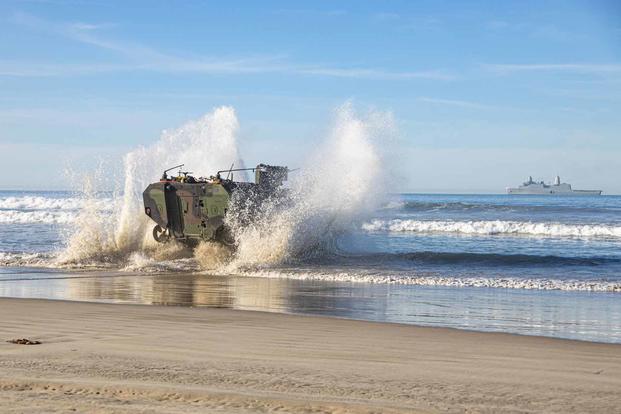The Marine Corps announced it is again pausing all water-based activities of its new Amphibious Combat Vehicle, or ACV, after two were disabled in heavy surf off the California coast on Tuesday.
Although the incident did not result in injuries to the Marines and sailors aboard the ACVs, the Marine Corps said it is pausing operations "out of an abundance of caution" in a statement released Wednesday evening.
The pause is the latest in a series of issues for the Corps' amphibious vehicle fleet, including a deadly incident in 2020 that exposed maintenance problems, safety shortcuts and mechanical failures with the ACV's predecessor, the amphibious assault vehicle, or AAV.
Read Next: Sailors Waiting Months for Separation Orders, with Bills Growing and Lives Put on Hold
The latest incident was first reported by USNI. In video obtained by the outlet, waves can be seen washing over two ACVs close to shore as recovery craft maneuver nearby.
An earlier Marine Corps statement also released Wednesday said that one ACV tipped onto its side in the surf zone and the other became disabled.
The National Weather Service had issued a high-surf advisory for both San Diego and Orange counties at the time of the incident -- an area that includes Camp Pendleton and its 16-mile Pacific Ocean shoreline.
"Marines in both ACVs conducted their immediate action drills and safely returned to shore," the earlier statement said. "One vehicle was towed ashore and recovery efforts for the other vehicle are ongoing."
"The pause of waterborne operations will allow for an investigation into the incident and ensure the assault amphibian community can review best practices and procedures to remain capable, safe, and ready," Lt. Gen. David Furness, deputy commandant for Plans, Policies and Operations, said in the later statement.
Since the 1970s, the Marine Corps has relied on AAVs to ferry Marines from Navy ships to shore. However, by 2020, the vehicles were aging, and a mishap in which one AAV flooded and sank while conducting an exercise off the coast of southern California claimed the lives of eight Marines and a Navy corpsman.
Four subsequent investigations by both the Marine Corps and the Navy found that the incident was "preventable."
Just months after the AAV sinking, the Marine Corps announced that ACVs would begin replacing the aging vehicles ahead of schedule.
However, that rollout hasn't been without faults, either. In the winter of 2021, the Marines pulled the ACVs out of the water for the first time over issues with the towing mechanism. Then in December, the Corps said it was also grounding its AAVs for the foreseeable future, leaving the branch with no "ship-to-shore connector" vehicles.
The service noted in Wednesday's statement that amphibious operations are "a foundational aspect of Marine Corps operations and critical to the future force and its ability to remain the Nation's premier expeditionary force in readiness."
While the pause is in effect, the Corps said that land exercises, including live-fire training, will continue.
-- Konstantin Toropin can be reached at konstantin.toropin@military.com. Follow him on Twitter @ktoropin.
Related: The Marine Corps' Aging Amphibious Vehicle Fleet Will Be Kept Out of the Water















